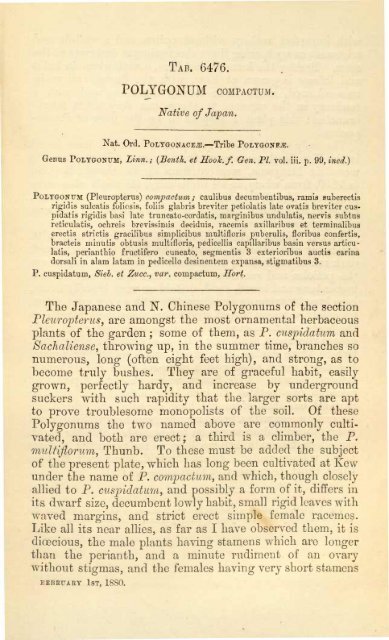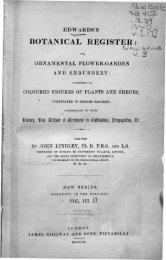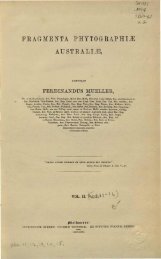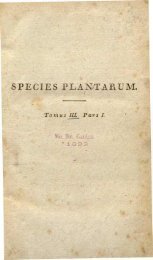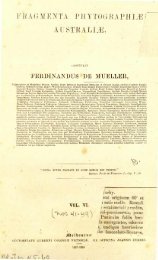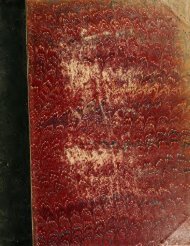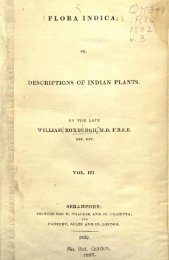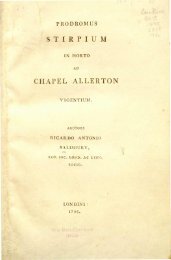Botanical Magazine 106 - 1880.pdf - hibiscus.org
Botanical Magazine 106 - 1880.pdf - hibiscus.org
Botanical Magazine 106 - 1880.pdf - hibiscus.org
You also want an ePaper? Increase the reach of your titles
YUMPU automatically turns print PDFs into web optimized ePapers that Google loves.
TAB. 6476.<br />
POLYGONUM COMPACTUM.<br />
Native of Japan.<br />
Nat. Ord. POLYGONACEíE.•Tribe POLYGONEN.<br />
Genus POLYGONUM, Zinn.; (Benth. et Hook. f. Gen. PL vol. iii. p. 99, ined.<br />
POLYGONTJM (Pleuropterus) compactum ; caulibus decumbentibus, ramis suberectis<br />
rigidis sulcatis foliosis, foliis glabris breviter petiolatis late ovatis breviter cus-<br />
pidatis rigidis basi late truncato-cordatis, marginibus undulatis, nervis subtus<br />
reticulatis, ocbreis brevissiruis deciduis, racemis axillaribus et terminalibus<br />
erectis strictis gracilibus simplicibus multifloris puberulis, floribus confertis,<br />
bracteis minutis obtusis multifloris, pedicellis capillaribus basin versus articu-<br />
latis, periantbio fructífero cuneato, segmentis 3 exterioribus auctis carina<br />
dorsali in alam latam in pedicello desinentem expansa, stigmatibus 3.<br />
P. cuspidatum, Sieb, et Zuce, var. compactum, Hort.<br />
The Japanese and JS". Chinese Polygonums of the section<br />
Pleuropterus, are amongst the most ornamental herbaceous<br />
plants of the garden ; some of them, as P. cuspidatum and<br />
Sachaliense, throwing up, in the summer time, branches so<br />
numerous, long (often eight feet high), and strong, as to<br />
become truly bushes. They are of graceful habit, easily<br />
grown, perfectly hardy, and increase by underground<br />
suckers with such rapidity that the larger sorts are apt<br />
to prove troublesome monopolists of the soil. Of these<br />
Polygonums the two named above are commonly culti-<br />
vated, and both are erect; a third is a climber, the P.<br />
multiflorum, Thunb. To these must be added the subject<br />
of the present plate, which has long been cultivated at Kew<br />
under the name of P. compactum, and which, though closely<br />
allied to P. cuspidatum, and possibly a form of it, differs in<br />
its dwarf size, decumbent lowly habit, small rigid leaves with<br />
waved margins, and strict erect simple female racemes.<br />
Like all its near allies, as far as I have observed them, it is<br />
dioecious, the male plants having stamens which are longer<br />
than the perianth, and a minute rudiment of an ovary<br />
without stigmas, and the females having very short stamens<br />
EEIiRT/AEY 1ST, 1880.


